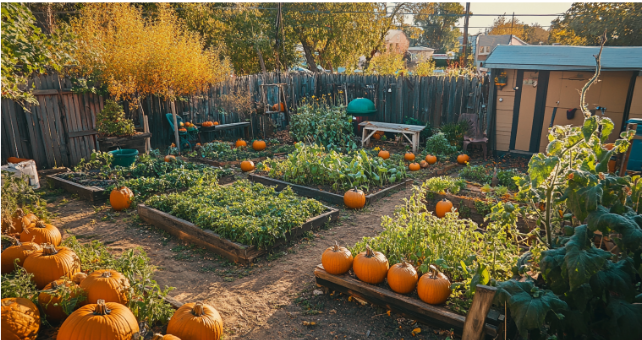There’s something magical about watching a pumpkin patch spring to life in your backyard. Imagine stepping outside to see vines curling while bright orange pumpkins take shape. Whether you’re growing them for pies, decorations, or Halloween, this gardening adventure can be incredibly rewarding. It doesn’t require magic, but there are a few essential steps to ensure your patch thrives.
Want to see your pumpkin patch flourish? Discover how to go from planting seeds to harvesting a bumper crop!
Choose the Right Pumpkin Seeds for a Healthy Patch
The key to a successful pumpkin patch starts with selecting the right variety of seeds. Pumpkins come in many shapes, sizes, and even colors. Your choice should align with your goals: are you growing them for giant displays, cooking, or decoration?
Here are some popular varieties to consider:
- Jack-O’-Lantern: Ideal for carving and Halloween fun.
- Sugar Pumpkins: Small, sweet, and perfect for baking pies.
- Cinderella Pumpkins: With a fairy-tale look, these are great for decoration.
- Atlantic Giant: This variety is the go-to for massive pumpkins, sometimes weighing over 1000 lbs!
Before planting, plan your space accordingly. Some varieties like the Atlantic Giant need up to 30 square feet per plant to grow well. For detailed tips on frost dates and planting schedules, check out The Old Farmer’s Almanac.
Planting Tips: Timing Is Critical for Pumpkin Success
Timing your planting is essential for pumpkin growth. Pumpkins thrive in warm soil, so wait until the risk of frost has passed and the soil has warmed to at least 65°F. For most regions, this is usually in late spring to early summer.
If you want to get a head start, you can sow seeds indoors a few weeks before the last frost date. Once your garden soil is ready, plant seeds directly into the ground in small mounds spaced 4-5 feet apart. Mounding helps with better drainage and warms the soil faster.
- Place 2-3 seeds per mound, then thin to the strongest plant once they sprout.
- Enrich the soil with plenty of compost before planting for nutrient-rich growth.
- Water deeply but infrequently, always focusing on the roots to avoid fungal diseases like powdery mildew.
Nurturing Your Pumpkin Vines: Care Tips for Healthy Growth
As your pumpkins grow, they will start sprawling and sending vines in every direction. Guide their growth carefully, especially if space is limited. Pumpkins need 6-8 hours of direct sunlight each day, so ensure they’re placed in a sunny spot.
- Keep the soil consistently moist without allowing it to become waterlogged. A layer of mulch helps retain moisture and reduces weed competition.
- Fertilize every 2-3 weeks with a phosphorus and potassium-rich fertilizer to promote healthy fruit production.
Mulching and regular feeding are key components of successful pumpkin growth. Your plants are ready to take off!
Boost Pumpkin Harvest with Effective Pollination
Pumpkins rely on bees and other pollinators to produce fruit. Each plant produces both male and female flowers. Pollinators transfer pollen from the male flowers to the female ones, but in areas with fewer pollinators, you may need to help with hand-pollination.
Use a small brush to transfer pollen from the male flower (the ones without a small pumpkin at the base) to a female flower. This technique can ensure a healthy fruit set, even if bee populations are low. For more on hand-pollination, visit the experts at Gardener’s Supply.
Tackling Common Pumpkin Problems
Growing pumpkins can be a straightforward and enjoyable process, but every gardener may face challenges along the way. Common pests and diseases can impact your pumpkin crop if not managed properly. Knowing how to prevent and tackle these problems will help ensure a healthy and abundant harvest.
Powdery Mildew: A Common Fungal Threat
Powdery mildew is a widespread fungal disease that often affects pumpkins. It appears as white or grayish powdery spots on the leaves and stems, which can eventually cause the foliage to yellow, wilt, and die. This reduces the plant’s ability to photosynthesize, impacting pumpkin growth and fruit development.
Prevention Tips
Keeping your pumpkin patch healthy requires proactive care to fend off common challenges. Proper spacing, the right watering techniques, and the use of resistant varieties can create an environment where your pumpkins thrive, free from fungal threats. Simple preventive steps can also make the difference in achieving a successful and abundant harvest.
- Air Circulation: Ensure good air circulation between the vines. Spacing plants adequately prevents crowding, allowing airflow that reduces moisture buildup—a prime condition for fungal growth.
- Watering at the Base: Always water the soil, not the leaves, to keep the foliage dry. Moisture on the leaves creates an ideal environment for powdery mildew.
- Mulching: Use mulch around the base of the plants to keep soil moisture consistent. Mulch helps reduce the chances of splashing water onto leaves during rainfall or irrigation.
Treatment Options
When powdery mildew appears, taking swift action can protect your pumpkin patch. There are several natural and effective ways to manage the problem without disrupting the ecosystem. Here are practical solutions to help keep your pumpkins disease-free.
- Remove Affected Leaves: If you notice signs of powdery mildew, prune the affected leaves immediately to prevent it from spreading.
- Organic Fungicides: Apply organic fungicides like neem oil or sulfur-based sprays. These can effectively control the disease without harming beneficial insects.
- Milk Spray: A mixture of milk and water (1:9 ratio) can be sprayed on affected areas as a natural remedy to prevent further spread.
Squash Bugs: A Serious Pumpkin Pest
Squash bugs are among the most common and damaging pests for pumpkins. These insects suck the sap from the leaves, causing them to wilt and eventually die. Infestations can lead to severe damage if not managed early.
Prevention Tips
Preventing squash bugs requires a combination of vigilance and smart gardening techniques. Regularly check your plants and use strategic planting methods to minimize the risk of infestations. Simple measures taken early in the growing season can make all the difference for a healthy pumpkin patch.
- Early Detection: Regularly inspect the undersides of leaves for eggs and remove them by hand.
- Companion Planting: Use companion plants like nasturtiums, radishes, and marigolds, which can deter squash bugs.
- Crop Rotation: Avoid planting pumpkins in the same location each year to reduce pest populations.
- Row Covers: Use floating row covers early in the season to prevent adult squash bugs from laying eggs. Remove covers when plants start to flower for pollination.
Treatment Options
Managing squash bugs requires targeted treatments for your pumpkins. There are several natural and effective ways to control these pests, each suited to different levels of infestation. Simple, hands-on methods can go a long way in maintaining a healthy garden.
- Hand Removal: Pick off any visible bugs and eggs by hand. This is labor-intensive but effective for small gardens.
- Organic Insecticidal Soap: Spray insecticidal soap directly onto squash bugs. It kills them by breaking down their outer layer.
- Diatomaceous Earth: Sprinkle food-grade diatomaceous earth around the base of plants. This natural powder cuts the exoskeleton of bugs, leading to dehydration.
Cucumber Beetles: Small but Dangerous
Cucumber beetles are another frequent pest that can wreak havoc on pumpkin patches. These beetles are small, striped or spotted, and they not only chew on leaves and flowers but also carry bacterial wilt—a disease that can quickly kill pumpkin vines.
Prevention Tips
Preventing cucumber beetles involves a mix of smart planting choices and natural pest control. By selecting the right pumpkin varieties and using targeted prevention methods, you can reduce the impact of these pests. A few simple strategies can keep your garden thriving without harmful chemicals.
- Resistant Varieties: Choose pumpkin varieties that are less susceptible to cucumber beetles.
- Beneficial Insects: Introduce natural predators like ladybugs and lacewings to your garden. They help keep beetle populations in check.
- Sticky Traps: Use yellow sticky traps around your garden to catch adult beetles before they can lay eggs.
- Row Covers: Protect young plants with row covers, similar to squash bug prevention.
Treatment Options
Effectively managing cucumber beetles requires prompt and targeted actions. There are natural solutions that can help minimize their impact on your pumpkin patch. These treatments are both environmentally friendly and effective in reducing beetle damage.
- Hand Removal: If you spot cucumber beetles, remove them by hand to reduce immediate damage.
- Neem Oil: Spray neem oil as an organic pesticide to repel beetles. Reapply after rain or heavy watering.
- Bacillus thuringiensis (Bt): Use Bt, a natural bacterial insecticide, as a treatment against cucumber beetle larvae.
Harvesting Your Pumpkins: Signs It’s Time to Pick
When fall approaches, your pumpkins will start ripening. Their skins will deepen in color, and the vines will begin to wither—signaling it’s harvest time.
- Use a sharp knife or pruning shears to cut the pumpkin from the vine, leaving 2-3 inches of stem attached.
- Allow the pumpkins to cure in the sun for about a week. This will harden their skin and extend their storage life.
With proper curing, pumpkins can last for months in storage. Whether you’re using them for pies, soups, or decorations, the satisfaction of harvesting your own pumpkins is undeniable.
Reap the Rewards of Your Thriving Pumpkin Patch
There’s nothing quite like the joy of harvesting your own pumpkins. By following these essential steps—from seed selection to harvest—you’ll be well on your way to cultivating a vibrant and healthy pumpkin patch. Start your fall gardening prep today and watch your pumpkins grow big, bold, and beautiful.



